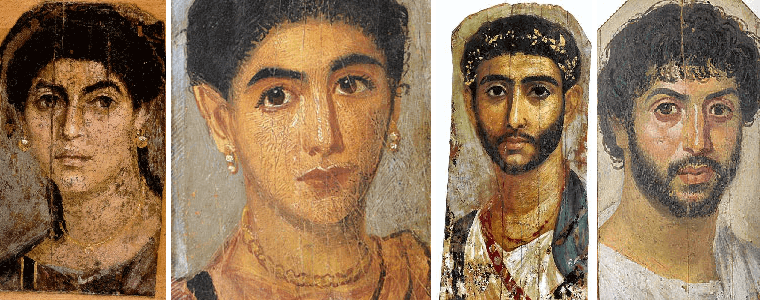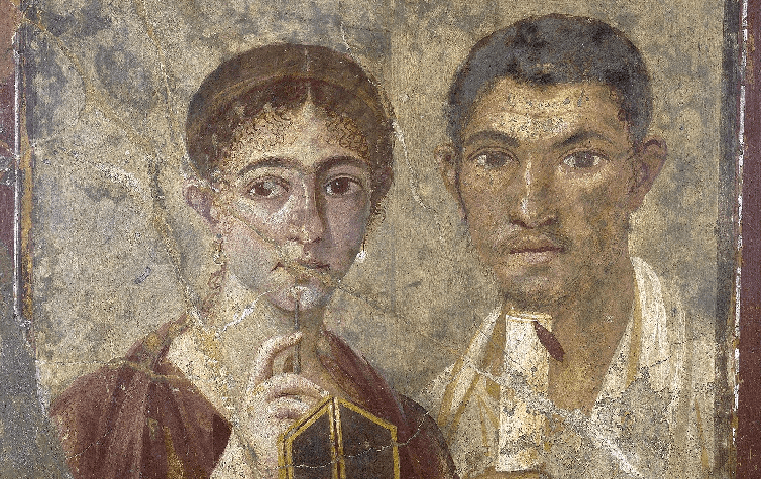The art of portrait
- 25/11/2016
THE PORTRAIT: FUNERAL AND SPIRITUAL ART
In the same way as watercolor or figurative art, the representations of portraits draw their origin from the ancient era.
The very first portrait is attributed to the artists of the Old Egyptian Empire (2700-2300 BC).
Entirely dedicated to the deceased, to kings and to divinities, these portrait paintings are not made to be seen by the living but intended for the spiritual world.
Even if they do not have the meaning that we give to the portrait today, their codes are specific and these "funeral portraits" are dependent on the social importance of the subject produced.
Within this same Egypt, in the first century of our era, the famous "Portraits of Fayoum" arrive.
This set of paintings produced from the end of the reign of the Roman Emperor Tiberius until the 4th century, represents funerary portraits painted and inserted into the strips at the level of the face of the mummy concerned.

Other civilizations like that of the Romans or the Greeks, few paintings have survived, but the literary sources of the time, in particular the writings of Pliny the Elder, are unanimous and bear witness to this Art of portraiture.
"The painting of portraits which serves to transmit through the ages the precise resemblances of people, has entirely disappeared ... indolence has destroyed the arts".
From the time, it is possible to categorize portrait painting into two groups: the portraits relating to funeral art which play the role of commemoration and remembrance and the portraits which concern the glorifying art.
Pliny the Elder also mentioned on this subject "By this art of portraiture, the nobles were even more noble".
This Art is intended for those who do not know the represented and it quickly spreads even to the less famous, as evidenced by this fresco from Pompeii representing a baker and his wife as two great characters.
Although popular, Greek and Roman portraits were to be extinguished by the rise of Christianity and the advent of Christian thought.
THE ELLIPSE OF THE MIDDLE AGES
Like any monotheistic religion, Christianity maintains uncertain relations with the representation of man and the image in general.
In the first centuries of the Middle Ages, it is the prohibition to paint or sculpt human beings that predominates.
The Church governs the art of portraiture in its own way and in fear of idolatry, only sacred scenes are allowed to decorate religious buildings.
After nearly a millennium of being shelved, the Art of the portrait is gradually coming back to the fore.


For William of Ockham (1285-1347), it is absolutely necessary to separate Faith and Reason for painting to evolve.
Popes and great patrons, whose donations make it possible to beautify or restore churches, are often distinctly represented kneeling at the feet of Christ, the Virgin or a saint offering a miniature replica of the building concerned.
It was in the second part of the 14th century that the portrait emancipated itself and finally secularized to become a genre apart.
"MAN IS THE MODEL OF THE WORLD"
The Renaissance, its humanist trends, its interest in the natural world as well as in the ancient cultures of Greece and Rome, marked a turning point for the future of portraiture.
This period of praise of the individual is fertile for the advent of portraiture as an artistic genre.
By following the evolution and innovations of society and of Art in general, portraits adopt several forms, poses and techniques.
They mainly develop in Italy, Florence, and Flanders.
Each of these trends influences the genre according to its sensitivity.
In the country of Leonardo da Vinci, Sandro Botticelli and Michelangelo, personalities are most often painted in bust.
From this school was born the most famous portrait of the Western world: Mona Lisa.
The Flemish painters, Jan van Eyck, Lucas Cranach, Albrecht Dürer, abandon tempera for oil painting and produce ultra-realistic, three-quarter-oriented paintings, as evidenced by The Portrait of Thomas More (1527) by Hans Holbein the Younger.

In the 16th century, the Art of the portrait became a court art under the impetus of the school of Venice and the painters Giorgione and Titian.
While some great artists occasionally practice this art, others make it their specialty such as Rubens or Van Dyck who sublimate the portrait of the Prince of England in a 17th century Europe increasingly fond of the genre.
So much so that the rich merchants or the members of the petty bourgeoisie eager for social recognition no longer hesitate to order.
PORTRAIT PAINTINGS: AN EVOLVING ART
The history of Art has always been partly dictated by the evolution of the world, religion and often even by the geopolitical context.
The history of portraiture is no exception to this rule: in France after the religious battles, portraits reflect the austerity desired by the post-war restrictions.
In the middle of the XVIIth century, the portrait puts on its ceremonial clothes to represent the great official dignitaries of the regime in a strict but advantageous way.
In Holland, while Batavian artists receive no commission from the Calvinist Church, group portraits are produced in large numbers.
After righteousness and rigor, in the 17th century, the Art of portraiture still evolves with Baroque and Rococo: cheerful movements and colors become more important than the realistic finishes that previously dominated.
The psychological research is more advanced and worked, the artists concentrate from now on on the expressions, the glance, the smile of the subject.
Pastel portraits, under the influence of Quentin de la Tour or Jean-Baptiste Perronneau, stand out as the fashionable genre.
The Age of Enlightenment gave birth to a current dear to Jean-Jacques Rousseau: sentimentalism, perfectly represented in the portraits of Elisabeth Vigée Lebrun for example.

If, in the midst of the industrial revolution, the bourgeoisie, which has gained purchasing power allowing it to become a sponsor, likes to have their portrait taken, the invention and the rise of photography allow the genre to renew itself.
Affected by the main artistic movements, the Art of the portrait is also declined between Neoclassicism, Romanticism, Realism and Impressionism.
The relationship of artists to figuration being modified, the devaluation of the notion of resemblance combined with the birth of abstraction, with Kandinsky in 1910, allows artists to use the portrait as a pretext.
It essentially becomes a way of representing something rather than someone.
Fauves and Cubists continue to lead the way traced by their predecessors: the portrait matters less than the painting itself.
In the 1960s and 1970s, there was renewed interest in portraiture with a more realistic aim.
American artists Andy Warhol, Alex Katz and Chuck Close make the human face the starting point of their work.
Lucian Freud (grandson of) and Francis Bacon produce eloquent paintings.
Freud's portrait "Benefits Supervisor Sleeping" (1995) even sold for nearly $ 34 million at auction.

Whether ceremonial, psychological, allegorical, intimate, mimetic or idealized, in the history of Art, the portrait always responds to the same objectives and the same questions.
The desire for idealization and realism is even more relevant than ever, where each of us wants to appear in public or on social networks under his best profile.
LUIS ALVAREZ TOREZANO, THE LOVE OF THE PORTRAIT
Originally from Pontedeume in the Galician province of La Coruna in Spain, Luis Alvarez Torezano grew up with brushes in hand.
After making his first oil painting at the age of 14, painting became his passion, "his life companion".
Even if he is professionally oriented in architecture, he continues in his creative path by brilliantly carrying out poignant portraits.
He chooses his models according to what they give off artistically or visually.
After starting to reproduce a photo in pencil, he painted the portrait in acrylics emphasizing every detail.
Luis Alvarez Torezano praises the myriad of emotions that the human face is capable of conveying and emphasizes each particularity in order to share with the viewer the intensity he himself felt when he first looked at his model.
.







62.png)







